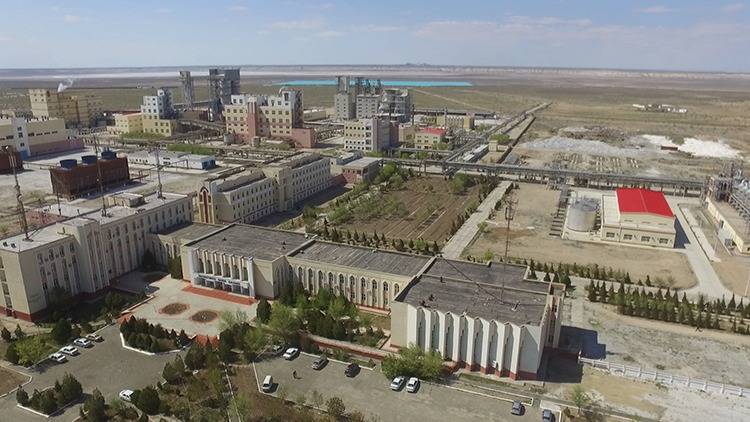
Kungrad District is a district in the Republic of Karakalpakstan. It was established on July 24, 1927[2]. In 1963, it was annexed to Khojaly District. It was reorganized on February 22, 1964. It borders Moynaq District to the northeast, Bozatov District to the east across the Amu Darya River, Kanlikol and Shumanay Districts to the southeast, Tashkhovuz Region of Turkmenistan to the south, and Atyrau and Aktobe Regions of the Republic of Kazakhstan to the west and north. Its area is 74.49 thousand km2. It is the largest district of the Republic of Karakalpakstan in terms of area. The population is 113.2 thousand people (2005)[3]. The district has 1 city (Kungirat), 6 towns (Jaslyk, Altynkol, Aksholak, Elabad, Karakalpakstan, South Ustyurt), 9 rural settlements (Ajinyoz, Navruz, Ornek, Ravshan, Suenlli, Ustyurt, Khorezm, Kipchak, Kungirat). The center is the city of Kungirat[4].
Nature
The surface of the land is mainly the Ustyurt plateau. The average height is 150–200 m, the highest point is 290 m (on the Karabo-Vur ridge in the western part of the district). In the central part are Borsa-Kelmas, in the east are the Karaumbet salt marshes, in the south are the Asakaovdon swamps, in the northern part of the Koplonkyr plain and Lake Sarikamysh in the border area with Turkmenistan. The climate is sharply continental, dry. Summers are hot, winters are cold. The average temperature in January is from -4.2°C to -6°C, in July it is 26.2°C, sometimes 28°C. The lowest temperature is in January -24°C, the highest temperature is in July 41°C. The average annual rainfall is 100 mm. The vegetation period is 155-165 days. In irrigated areas, it is 183 days. The farms of the district receive water from the Suelli main canal, Ravshan, and Altynkul canals. The district also includes Lake Mashan and the southern edge of Lake Suelli in the northern part. The soils on the Ustyurt plateau are mainly desert-brown, and in the irrigated eastern part, grassy and meadow soils. Salt-affected, barren soils and barrens are also found. Natural vegetation is mainly desert plants: wormwood (including wormwood), centipede, black saxaul, etc. There are also forests along the banks of the Amu Darya. Wild animals include saiga, wolf, fox, sandpiper, snake, lizard; rodents include muskrat, rats; birds include pheasant, crow, duck, kingfisher, and mallard; there are fish in the waters.
The population is mainly Karakalpaks, Uzbeks, and Kazakhs, as well as Koreans, Tatars, Russians, and representatives of other nationalities. The average population density is 1.52 people per km2 (2005). 41% of the population (44 thousand people) live in villages, and 59% (69.2 thousand people) live in cities.
Economy
Industrial enterprises include cotton ginning, flour milling, soda, reinforced concrete products factories, the unitary subsidiary "Ustyurtgaz", the Ustyurt exploration and drilling department, the 5th gas pipeline network department of the subsidiary "Urgenchtransgaz", the Kungirt technological water supply department, a locomotive and wagon repair depot, hydraulic structures, auto companies, construction organizations, the joint ventures "TuzLTD", "Qazkungirtkarbid", "N01T", a branch of the joint venture "Iygilikgaz", and others.
The main branches of the district's agriculture are cotton growing, grain growing (including rice growing), meat and dairy farming. There are companies and farms, 6 alternative MTPs, and the "Kungirt" machine-tractor fleet. In Kungirat district, 40 thousand hectares of land are irrigated. Of this, 4 thousand hectares are planted with cotton, 4 thousand hectares with rice, 5.6 thousand hectares with wheat, and 500 hectares with other agricultural crops. About 170.9 thousand hectares of land are forested (mainly saxaul, turangil, etc.). The remaining lands are hayfields and pastures. About 27.6 thousand cattle (including about 12 thousand cows), about 58.9 thousand sheep and goats, and about 1.2 thousand horses are kept in collective and private farms in the district. The Kungirat branch of the Muynak fish factory is operating.
In the 2004-2005 academic year, the district had 56 general education schools (over 26,000 students), 2 vocational colleges (3,300 students), a branch of a business school, the "Progress" training center, 21 libraries, and a district history museum. The district central hospital, a maternity hospital complex, dermatology and tuberculosis dispensaries, 3 polyclinics, 24 feldsher-obstetrician stations, 7 village medical stations, 2 rural medical clinics, a rural hospital, and other medical institutions employed 196 doctors and 1,084 paramedics. The total length of the district's roads is 996 km, of which 375.5 km are highways, and the length of the railways is 340 km. Part of the construction of the international road on the Great Silk Road is being carried out in the district. Since 1944, the district newspaper "Kungirot Haqiqat" has been published (circulation 2,300).
